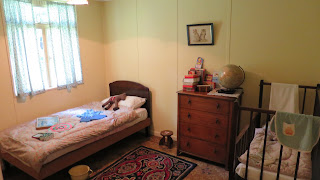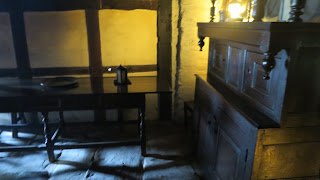Our Airbnb hosts are special education school teachers so when they suggested we may enjoy visiting this little gem that mostly only Welsh folk know about, we jumped on the opportunity. It was about ten miles from our Cardiff home. Downtown was still humming with the race and you all know how we like to stay away from crowds so we decided to give it a go, as they say.
What an amazing outdoor museum celebrating Welsh life and culture. And it was free. The center just opened their new visitor center yesterday and we were one of the first guests through the doors. The guest areas were luxurious and posh. They has a lovely cafeteria serving traditional Welsh food, the staff was well trained and spoke Welsh, as well as English of course, and the grounds were beautifully maintained. The park is a cultural enterprise funded solely by the government and donations. There are over 60 building that have been brought in and painstakingly rebuilt and restored, furnished, and it was about as authentic as it gets.
The park covers about 400 acres and we walked every trail and entered and viewed every building.
The building go back as far as 1360. This first collection was a farmhouse complete with pig sty. The slate stacked fence was impressive.
The interior is completed set with period pieces and there was a docent at all exhibits. They were all friendly, informative, and obviously proud of their site.
Check out the braided mats on the roof. On the outside the thatch is attached to the mats to keep it from blowing off and it is completely waterproof.
Pretty much each exhibit also had a representative garden. This one was full of apple tree with ripening fruit.
The meadows were full of Welsh sheep, hogs, cattle, and goats.
This is a corn mill. The wooden husker dates back to the 1700s.
This fellow was proudly protecting his family. It has a lot to brag about if you take a good look at the photo!@
This farm dates back to the early 1800s. It was an operating dairy farm until 1942 when the war caused it to shut down. It is one of the few buildings that actually stands in it's original locaiton.
Baby piglets seemed happy to see us and were very animated and curious.
The geese where also curious but as watch dogs.
Welsh Black Cattle. Awesome horns.
The forest and glens were spectacular with 100' tall hardwood trees.
A workman's cottage. Most were occupied by tenant farmers and their families. There were fires burning in every fireplace.
This stone home dates back to 1470 and housed a farmer, his wife and SIX children, their maid and farmhand, and several animals. It was at most 20' X 20" inside. Yikes!!!
The china and pottery on display was tradition Welsh design and we were told that many were of museum quality...simply placed on the shelf for folks and kids to touch.
This is a toll house from the early 19th century. Landowners (lords and barons) would gate off the roads and charge a toll for anyone passing. Read the original tariff notice on the wall.
We popped into the bakery and enjoyed freshly baked raisin scones with butter and berry jam.
This proudly claimed to the smallest post office in Wales and still operates as one.
This is a cockpit. A place where cock fighting took place.
There was a string of shops, all stocked and open. Each offered replica items for sale.
The childrens carnival rides date back to the late 19th century.
The carosel animals were beautifully restored and all of the rides functioned. If it wasn't for the rain coming and going, I'm sure they would have been busy since the rides were only 25 cents each.
A country mansion full of antique furniture. This would have belonged to a land baron.
A pottery kiln.
A leather tannery.
A grist mill.
A spectacular church, the oldest building in the park. Originally Catholic, then Anglican, then Islamic, then a synagogue, The original fresco were whitewashed over and new ones painted depending on the denomination and sue so many times over the centuries that no one knew the originals existed until the church was dismantled and reassembled. They have all been painstakingly restored.
This stone house is the second oldest in the park, was on the site of the St. Fagans battleground, and was in the process of being restored. Look at the stone masonry.
After WW2 the government supplies these prefabricated alumimum houses to folks whose homes were destroyed by the air raids. The house was furnished as it would have been in 1950. There were over 3,000 of them constructed and given to the people.
Another old farmhouse, this time one that was shared by both the family and their critters. They all used the same entrance door.
There was a bit of a craft fair going one. This fellow was doing chainsaw sculptures. It was totally out of charcter for the park so we aren't sure why he was there...but he did do nice work.
We took a lunch break and enjoyed a picnic back the visitor center. There were families and couples all over doing the same thing. The atmosphere was very festive and the weather was holding nicely. After lunch we still had the other half of the park to cover. Next up with St. Fagan's Castle, an English manor house and formal gardens. It was built back in the 1700s and was a home of both the wealthy and nobility. Prince Charles donated many of the garden renovations. There were ponds and formal gardens all around the manor. AND. it started to pour...and that did not stop us.
A flowering artichoke.
The home itself was very stately and of course properly furnished.
The highlight for us was the kitchen and we did a few sketches.
The hearth is equipped with automatic meat roast hooks and rotisseries. I want one when we get bck in five year!
This was a public restroom dating back to 1912,
An apple cider mill.
A display of cockelll harvesting display, This are boats.
A woolen mill weaving traditonal blankets and throws for sale in the store.
A wheat thrashing barn.
Our visit ended after five hours and we drove back to our Cardiff home with wonderful memories. We left a very nice donation at the visitor center. It was a spectacular visit.

















































































































































No comments:
Post a Comment